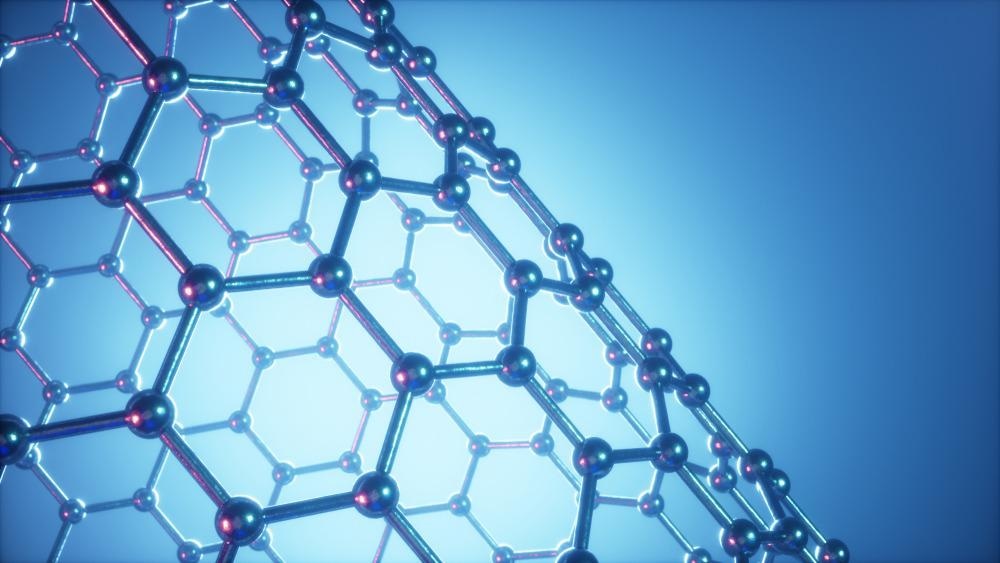Nanotechnology research is increasingly gaining attention. In recent years, numerous applications of nanomaterials have been established in a wide range of industries. Due to their nano-size, these structures have unique properties that their compound counterpart materials do not have. It is these unique properties that are being leveraged into essential applications benefiting the fields of pharmaceuticals, healthcare, clean energy, and more.

Image Credit: Rost9/Shutterstock.com
Each year, scientists are developing new uses for nanostructures. Recently, investigations into carbon nitride (CN), a two-dimensional material constructed of just carbon and nitrogen linked via strong covalent bonds, have led to the development of the material as a metal-devoid and visible-light-active photocatalyst.
CN’s adjustable energy-band positions, high thermal, chemical, and mechanical stability, and low cost lend itself to use in such applications.
Research has demonstrated that CNs can replace traditional, metal-based inorganic photocatalysts for use in a more sustainable and environmentally friendly process.
Here, we discuss how the unique properties of nanostructured carbon (specifically, CN) are being leveraged to address climate change.
Nanostructured Carbon and Carbon Capture
As pressures increase to reduce global emissions to meet the goals of the Paris Agreement, which, as time moves on, are becoming more challenging to meet, research has increased into innovations that can reduce carbon emissions and remove carbon from the atmosphere.
There are two approaches to tackling climate change; the first is changing human activities that emit greenhouse gases so that they no longer do so, for example, switching from fossil fuels to renewables as an energy source. The other approach is pulling the carbon already in the atmosphere and either capturing it or utilizing it. These approaches can be used in unison.
Nanotechnology has become crucial to developing the field of carbon capture. Already, many platforms have been developed using nanosensors and nanostructures for carbon capture and storage (CCS). However, CCS has several limitations preventing the application of this technology on industrial levels.
To overcome these limitations, scientists have been developing carbon capture and utilization (CCU) strategies, whereby carbon is captured and reutilized without the high operational costs associated with CCS. Rather than storing carbon, these strategies involve the conversion of carbon dioxide into chemicals - a solution that reduces the cost of keeping the compound.
Nanostructured materials have fostered important breakthroughs in the development of CCU technology. Scientists have proven that nanostructures can be functionalized and modified to boost their ability to capture carbon dioxide, as well as transform the greenhouse gas into useful compounds, including carbon monoxide, formaldehyde, formates, and methanol.
Recently, carbon nitrates have emerged as essential materials for carbon dioxide capture and their conversion into chemicals that can be used in low-carbon fuels and feedstock via photo(electro)catalysis.
CNs as Photocatalysts For Carbon Dioxide Reduction
Scientists have recently developed a method that converts carbon dioxide into valuable products via mimicking the natural process of photosynthesis. These processes leverage the natural high potential for carbon dioxide capture that CNs possess, using them as photocatalysts to convert carbon dioxide into carbon and oxygen. Several research studies have demonstrated that carbon dioxide can successfully be split into its components via CNs, the first of which was first reported back in 2006.
In recent years, studies have focussed on the CN of C3N4, which has a corrugated structure that enhances the compound’s stability while increasing the depth of the structure’s p-holes, vital to improving the material’s active sites for catalytic transformation. In 2012, scientists reported the photoreduction of carbon dioxide into carbon via the use of a C3N4 photocatalyst.
Future Directions for Nanotechnology in Mitigating Carbon Emissions
Since CNs were first successfully used as photocatalysts for CCU platforms, research has continued to further enhance this process. Recent explorations have revealed that the photocatalytic ability of CNs can be improved via the addition of metal and carbon species into their structure. Studies have indicated that the integration of metal-organic complexes, such as Co(bpy3)3Cl2 and Ru binuclear complexes can perform as homogenous electrochemical catalysts for the reduction of carbon dioxide.
Experts predict that CNs will be fundamental to the future development and advancement of CCU platforms. These nanostructures could feasibly be developed into technology that could be adopted on an industrial scale to capture carbon dioxide from major sources of emissions and convert it into reusable, useful compounds.
Scientists believe that the use of CNs in CCUs will address three important problems; it will overcome the issue of the cost of alternative carbon dioxide storage methods, it will help to reduce emissions and tackle climate change, and finally, it will convert carbon dioxide into much-needed chemicals in a sustainable way.
Continue reading: Nano-Intermetallic Catalyst Enables Step Towards CO2 Circular Economy.
References and Further Reading
Abu-Dief AM, Salaheldeen M, (2020) Opinion on nanomaterials for carbon capture and conversion. Material Sci & Eng,4(6), p.149‒150. Available at: https://doi.org/10.15406/mseij.2020.04.00142
Bai, L. et al., (2021) Role of transition metal oxides in G-C3N4-based heterojunctions for photocatalysis and Supercapacitors. Journal of Energy Chemistry, 64, pp.214–235. Available at: https://doi.org/10.1016/j.jechem.2021.04.057
Talapaneni, S.N. et al., (2019) Nanostructured carbon nitrides for CO 2 capture and conversion. Advanced Materials, 32(18), p.1904635. Available at: https://doi.org/10.1002/adma.201904635
Disclaimer: The views expressed here are those of the author expressed in their private capacity and do not necessarily represent the views of AZoM.com Limited T/A AZoNetwork the owner and operator of this website. This disclaimer forms part of the Terms and conditions of use of this website.